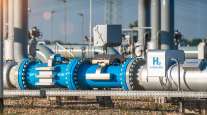Staff Reporter
Hydrogen Hubs Face Complex Timeline to Final Production

[Stay on top of transportation news: Get TTNews in your inbox.]
Seven state-backed regional hydrogen hubs that received the Biden administration’s green light face up to 12 years with intricate hurdles and “go/no-go” approvals before achieving commercial output no later than 2035, according to a U.S. Department of Energy timeline.
The federal government has developed a complex and wide-reaching national strategy and road map to turn hydrogen from its current infancy into a mainstay energy form to replace gasoline and diesel, particularly for heavy trucks carrying freight long distances.
The plan is to remove 25 million metric tons of carbon dioxide emissions from end-users each year equivalent to annual emissions from 5.5 million gasoline-fueled cars. The regional hydrogen hubs are supposed to yield nearly 8,000 metric tons of hydrogen tons daily.
The DOE’s initial national hydrogen strategy will focus on targeting “high impact” hydrogen usage in three “difficult-to-decarbonize” economic sectors: transportation (medium- and heavy-duty vehicles, maritime, aviation and rail), industry (steelmaking, industrial heating and chemical manufacturing) and energy (storage, electricity generation and supplies of backup and stationary power).
A key feature is replacing diesel trucks with fuel cell vehicles. “The overall challenge to hydrogen production is cost,” according to the DOE, which is developing ways to make hydrogen at $2 per kilogram by 2026 to drop further to $1 a kilogram by 2031. In seven years, the goal is for the cost of onboard storage to be $9 per kilowatt-hour and $2 per kilogram for hydrogen delivery and dispensing.
Not an energy source, hydrogen must be made from compounds that contain it before it can be used to carry energy to be stored and delivered. It can be created, for example, by splitting water into hydrogen and oxygen using sunlight and semiconductors or electrolyzers.
President Joe Biden and Energy Secretary Jennifer Granholm jointly announced Oct. 13 that the following regional hydrogen hubs were selected: Mid-Atlantic Hydrogen Hub (Pennsylvania, Delaware and New Jersey), the Appalachian Regional Hydrogen Hub (West Virginia, Ohio and Pennsylvania), California’s Alliance for Renewable Clean Hydrogen Energy Systems, Texas-led HyVelocity Hydrogen Hub, Heartland Hydrogen Hub (Minnesota, North Dakota and South Dakota), Midwest Alliance for Clean Hydrogen (Illinois, Indiana and Michigan) and the Pacific Northwest Hydrogen Hub (Washington state, Oregon and Montana).
So great to be back in the Mountain State with @MitchLandrieu46, @Sen_JoeManchin, and @SenCapito to celebrate the historic investment in the Appalachian Regional Clean Hydrogen Hub, which will deliver good-paying jobs across West Virginia. pic.twitter.com/60tDDvoC7P — Secretary Jennifer Granholm (@SecGranholm) October 16, 2023
The next step for the seven selected regional hydrogen hubs is to enter into negotiations with the federal government that detail requirements for labor, community involvement and other prerequisites. Virtual community briefings for each of the seven hubs have been scheduled online from Oct. 24 through Nov. 1.
Then there are four implementation phases. Phase 1 calls for detailed plans to be developed within a year to 18 months, before Phase 2 of project development begins within two to three years. Phase 3 will take another two years for the hydrogen hubs to be built, installed and integrated. In the final Phase 4, hydrogen hubs are to begin production and fully operate.
Each phase will include public involvement and community commitments to the public and subject to pass or fail (go/no-go) decisions by the DOE.
Want more news? Listen to today's daily briefing above or go here for more info
“During each phase of funding, each Hub awardee will actively engage with host communities, workers and other stakeholders to implement their Community Benefits Plan commitments. For instance, in the planning and permitting Phases (1 and 2) Community Benefits Agreements and Project Labor Agreements may be negotiated, and then implemented during the construction and operation Phases (3 and 4),” DOE says. “Successful implementation of the Community Benefits Plans commitments will inform “go/no-go” decisions of the project.”
Funded projects must submit detailed risk assessments and management plans outlining mitigation efforts. They also must submit hydrogen safety plans outlining how they will safely make, store and transport hydrogen.
DOE noted that it will ensure the hydrogen hubs comply with the National Environmental Policy Act, enacted in 1970 to mandate that federal agencies assess environmental impacts of their proposed actions before making decisions. NEPA covers a range of actions such as decisions on permit applications and building publicly owned facilities.




